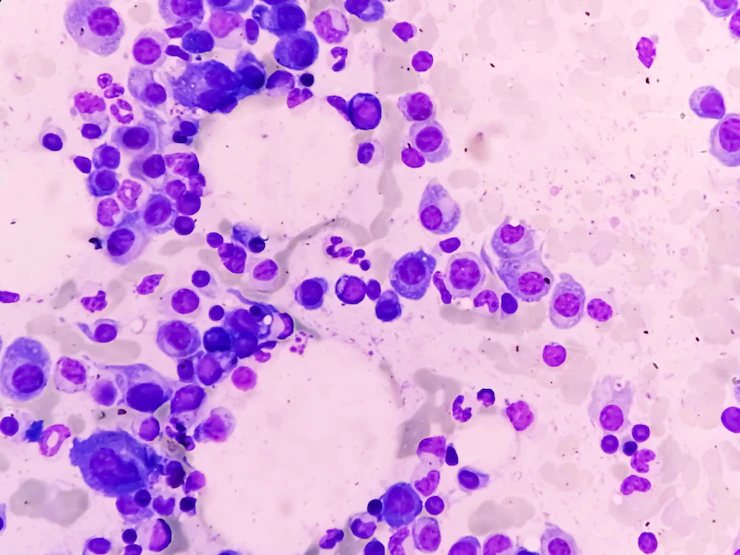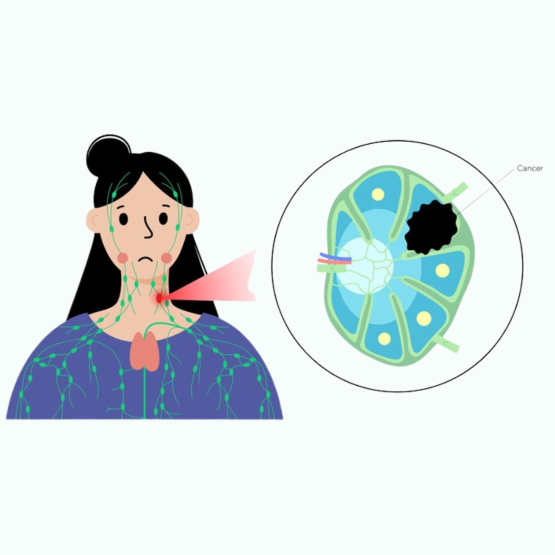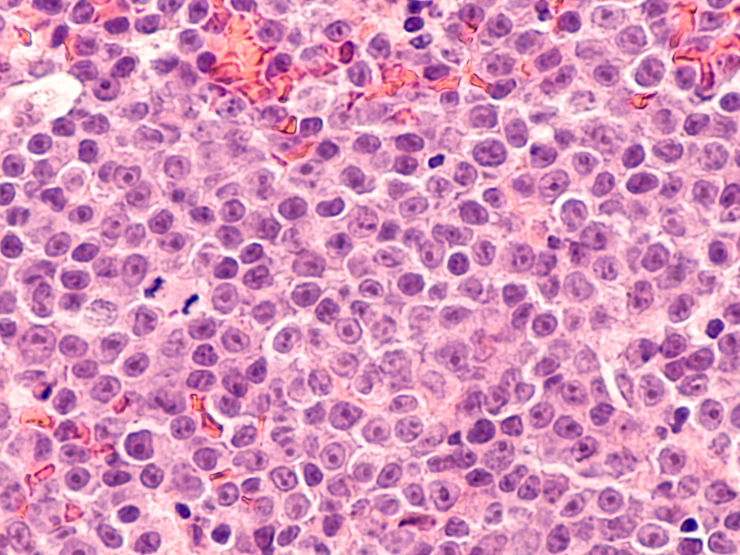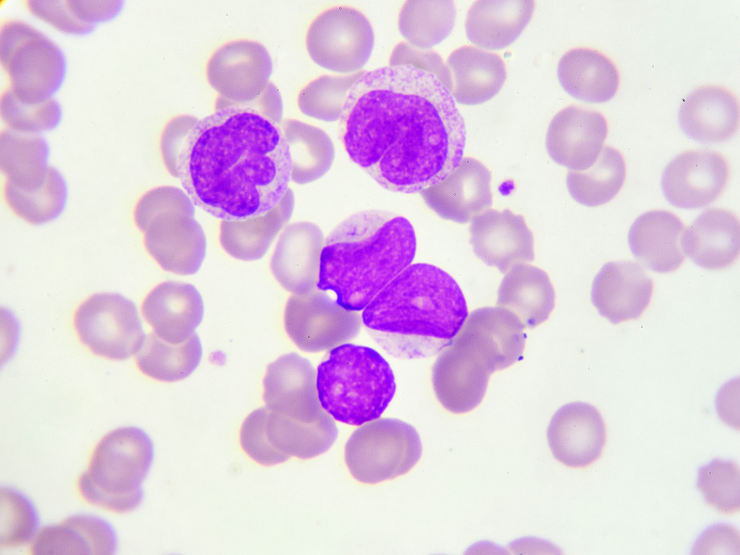Blood Cancer
When we refer to blood cancer, it is important to understand that it is not a single entity that we are referring to. Blood cancer is a very broad term for malignancies that arise from the bone marrow.
When a layman refers to blood cancer, it is generally one of the aggressive leukemias that is being spoken of.
Blood Cancer Symptoms
What are the symptoms of Blood Cancer?
Shortness of breath
Difficulty breathing or shortness of breath can be a sign of blood cancer, particularly if it is accompanied by other symptoms such as fatigue or chest pain.
Fever
A fever that comes and goes or does not respond to treatment can be a sign of an underlying condition, such as blood cancer.
Night sweats
Sweating excessively at night for no apparent reason can be a symptom of blood cancer.


Fatigue
Feeling tired or exhausted all the time is often one of the first signs of blood cancer.
Swelling in the lymph nodes
Swelling in the lymph nodes, particularly in the neck, underarm, or groin, can be a sign of blood cancer.
Weight loss
Losing weight without trying can be a sign of blood cancer, especially if it is accompanied by other symptoms such as fatigue or fever.
Understanding Blood Cancer Symptoms
Symptoms will vary depending on the type of blood cancer detected. Some of the symptoms common to most blood cancers are a low-grade fever, this is usually seen as an evening rise of temperature in a lymphoma.
- Leukemia can cause high fever and symptoms such as anorexia, weight loss, weakness, and fatigue.
- Leukemia patients may experience anemia, bleeding episodes, and an increased or decreased WBC count, leading to a higher risk of infections.
- Rapid proliferation of leukemia cells can cause a syndrome called tumor lysis, which can lead to acute renal failure.
- Multiple myeloma can cause opportunistic infections, back or joint pain, sudden paralysis of the lower limbs, spontaneous fractures of any bone or a fracture caused by a minor trauma, and sudden onset renal failure.
- Myeloma can also cause, anaemia, elevated calcium levels resulting in drowsiness, confusion and renal failure and bony destruction resulting in severe bone pain.
- Lymphoma can present with symptoms such as anorexia, weight loss, weakness, and fever, as well as enlarged lymph nodes, multiple organ involvement can occur resulting in liver and spleen enlargement, renal failure, lung involvement can cause cough and breathlessness.
- Rapidly growing lymphoma can cause tumor lysis and acute renal shutdown, mediastinal lymphoma can cause breathlessness, cough, chest pain and respiratory compromise.
- Lymphoma patients may also have compromised immunity, leading to bacterial and fungal infections.
See any Symptoms?
Detection Of Blood Cancer
There is no specific screening test for blood cancer. The diagnostic test differs depending on the type of blood cancer. A leukemia can be incidentally detected when a CBC is done as a routine test as a part of a health check, or when it is done for another unrelated condition. If the leukemia is developing, then changes in the hemoglobin, platelets, WBC counts, the differential count or atypical cells or blasts on peripheral smear examination would indicate the diagnosis. Once the patient is symptomatic, the CBC will show an increase or decrease in the WBC, hemoglobin and platelets. Blasts will be seen on the peripheral smear examination. A bone marrow aspiration and biopsy are then required. Tests are then performed on the bone marrow sample. Immunohistochemistry or Flow Cytometry is the primary test needed for diagnosis of the leukemia and its subtype. Additional tests include cytogenetics, karyotyping and FISH studies for chromosomal analysis and detection of mutations that can be targeted.
Blood test for Cancer
One way to help diagnose or monitor the progress of treatment is through a blood test. Dr. Sujata and her medical professionals use tests such as the complete blood count (CBC), tumor marker test, lactic acid dehydrogenase (LDH) test, and C-reactive protein (CRP) test to help assess patient health.
It is important to remember that a blood test alone is not usually enough to diagnose cancer, and other tests such as imaging studies or biopsies may also be necessary. If you have any questions or concerns about blood tests for cancer, speak with Dr. Sujata in detail.
Types of Blood Cancer
Acute leukemia are of two major types, with each type being further subdivided into several different cancers.
All acute leukemias are aggressive, fast-spreading, and universally lethal if not diagnosed and treated early. They develop rapidly and present suddenly, with fever, weakness, fatigue, and bleeding episodes being the common symptoms.
The 2 major types are Acute Myeloid and Acute Lymphoblastic leukemia. Both adults and children can be affected at all ages.
Chronic leukemias are of 2 types, Chronic Myeloid Leukemia (CML) and Chronic Lymphocytic Leukemia / Lymphoma (CLL). As their name suggests, they are slow growing and have a better prognosis than acute leukemias. Both can remain asymptomatic and be diagnosed incidentally on a routine check. CML can present with fever and abdominal pain as the spleen enlarges. An increasing WBC and Platelet count with a drop in Hemoglobin can be seen on CBC. It can be treated with an oral tablet and has an excellent prognosis.
CLL patients can be diagnosed when an elevated WBC count with lymphocytosis is seen on CBC. Changes in the hemoglobin and platelets occur with disease progression. Almost any lymph node group can be involved- in the neck, chest, and abdomen. CLL is an incurable illness and treatment is only initiated on disease progression or when the patient is symptomatic. A large number of patients can remain under observation life-long.


Multiple Myeloma
It is a slow-growing bone marrow tumor or blood cancer. It is incurable with currently available therapies and treatment is given with the aim of keeping the disease in remission and increasing progression-free survival. It originates in the bone marrow and spreads to involve the bones in the body, especially those of the axial skeleton. It can present with anemia, back ache, body pain, sudden onset renal failure, or an increase in creatinine with elevated calcium levels. With appropriate therapy, patients can have an average life span of 5 to 10 years.
Lymphomas
Are of 2 basic types, B and T cell lymphomas. Each is further subdivided into multiple other lymphomas, like Follicular, Mantle cell, Diffuse large B cell lymphoma, etc. A majority of lymphomas can be effectively treated with a combination of chemotherapy and targeted therapy. Most can be cured; the others can be controlled. They can have multiple presentations. Some may be detected incidentally, some are diagnosed when a patient develops a lymph node enlargement or complains of abdominal pain due to an enlarged liver or spleen.




Follicular Lymphoma
One of the commonest lymphomas seen. It is B cell in origin. It is a slow-growing lymphoma, often going undiagnosed for many years till the patient develops symptoms. It is incurable but can be well controlled with therapy. The treatment aims to keep the lymphoma in remission. Treatment is initiated only when the patient is symptomatic. The rest of the time, a policy of close observation is followed.
Diffuse Large B Cell Lymphoma
It is an aggressive B-cell lymphoma, that develops and spreads at a rapid pace. It can prove terminal if not diagnosed and treated promptly. Patients will present with multiple lymph node enlargements, abdominal pain, and chest pain, and other symptoms – depending on the areas of disease involvement, fever, appetite loss, weight loss, and fatigue may also be seen. A combination of chemotherapy and targeted therapy, called chemo-immunotherapy, forms the basis of the treatment protocols. The lymphoma can be cured completely depending on the stage at which it is detected.




Mantle Cell Lymphoma
Another extremely aggressive B cell lymphoma. It is considered one of the most lethal lymphomas. It is treated with targeted therapy with the addition of chemotherapy if required. Patients see frequent recurrences and require repeated treatment to keep the disease in check. Younger patients with refractory disease have the option of undergoing high-dose chemotherapy followed by a stem cell transplant.
Warning signs of blood cancer
Blood cancer, also known as hematological cancer, refers to a group of cancers that affect the production and function of blood cells. Some common warning signs of blood cancer can include:
- Gradual or sudden loss of appetite, weakness, fatigue, and disproportionate weight loss.
- Fever occurring daily, especially high grade, with no obvious source of infection and not responding to antibiotics.
- Severe anemia, with low hemoglobin detected on a CBC.
- Bleeding episodes, such as blood in the urine or stool, bleeding spots on the skin, vomiting, or cough with blood clots or streaks.
- Opportunistic infections, especially chest infections caused by fungal infections.
- Sudden onset swelling of the lymph nodes in the neck, armpits, thighs, groin, and above or below the collar bones.
- Increasing abdominal pain on the right or left side or involving the entire abdomen, due to liver or spleen enlargement or a lymph node mass.
- Back pain, due to retroperitoneal lymph node involvement.
- Bony pain can occur, a spontaneous fracture or a sudden fracture following a minor trauma may be seen.
- Gum bleeding and/or gum hypertrophy with or without pain can occur to due to involvement by the leukemic cells.
It’s important to note that these symptoms can be caused by a variety of conditions, and they don’t always indicate the presence of cancer. If you are experiencing any of these symptoms, it’s important to speak with a healthcare professional for a proper diagnosis.
Blood Cancer Treatment
- Treatment of blood cancer varies depending on the diagnosis and subtype.
- Acute leukemias require intensive chemotherapy and may also involve the use of targeted therapy.
- Acute lymphoblastic leukemia is treated with chemotherapy and oral steroids, with intrathecal or spinal chemotherapy injections given for CNS protection.
- Philadelphia chromosome positive leukemias will also require oral therapy with tyrosine kinase inhibitors.
- If acute leukemia relapses, a stem cell or bone marrow transplant may be necessary.
- Chronic myeloid leukemia can be treated with oral therapy using tyrosine kinase inhibitors and may require chemotherapy or a stem cell transplant in the case of disease relapse or refractory disease.
- Chronic lymphocytic lymphoma may be treated with oral tablets or targeted therapy, with chemotherapy reserved for resistant cases.
- Multiple myeloma is treated with a combination of oral steroids and targeted therapies, and may involve high dose chemotherapy and an autologous stem cell transplant in certain cases.
- Lymphomas are treated based on their subtype and molecular profile, with options including chemotherapy, targeted therapy, and Rituximab.
- If a lymphoma does not respond to initial therapy or relapses, high dose chemotherapy and an autologous stem cell transplant may be necessary.
- Maintenance therapy may be necessary to prevent disease recurrence.
- Acute Myeloid Leukemia requires treatment with high dose chemotherapy and targeted therapy depending on the underlying mutations detected.
- Treatment of blood cancer varies depending on the diagnosis and subtype.
- Acute leukemias require intensive chemotherapy and may also involve targeted therapy.
- Acute lymphoblastic leukemia is treated with chemotherapy and oral steroids, with intrathecal or spinal chemotherapy injections for CNS protection.
- Philadelphia chromosome positive leukemias may also require tyrosine kinase inhibitors.
- If acute leukemia relapses, a stem cell or bone marrow transplant may be necessary.
Chronic myeloid leukemia can be treated with tyrosine kinase therapy and may require chemotherapy or a stem cell transplant in the case of disease relapse or refractory disease.
Chronic lymphocytic lymphoma may be treated with oral tablets or targeted therapy, with chemotherapy reserved for resistant cases.
Multiple myeloma is treated with a combination of oral steroids and targeted therapies, and may involve high dose chemotherapy and an autologous stem cell transplant in certain cases.
Lymphomas are treated based on their subtype and molecular profile, with options including chemotherapy, targeted therapy, and Rituximab.
If a lymphoma does not respond to initial therapy or relapses, high dose chemotherapy and an autologous stem cell transplant may be necessary.
Maintenance therapy may be necessary to prevent disease recurrence.
Our Survival Stories
Types of Childhood Leukemia
Acute lymphoblastic leukemia/lymphoma (ALL)
Acute leukemia is a type of blood cancer that is commonly seen in children. Acute lymphoblastic leukemia/lymphoma (ALL) is the most common type of blood cancer in children and is characterized by the presence of cancer cells in the blood and bone marrow. When cancer cells are only present in the lymph nodes and not the bone marrow, it is called lymphoblastic lymphoma. When cancer cells are present in the bone marrow, it is called acute lymphoblastic leukemia.This type of blood cancer makes up about one-third of all cancers in children and has a high cure rate when treated promptly and with the appropriate treatment protocols. With intensive chemotherapy, up to 80-90% of affected patients can achieve a long-term remission and cure. In cases where the disease is resistant or does not respond to chemotherapy, a stem cell transplant may be necessary to achieve a cure.


Acute Myeloid Leukemia: (AML)
This makes up the other type of acute leukemia seen in children, although it is less common then ALL. It makes up about 15% of the blood cancers seen in children and adolescents. It is subdivided into various molecular subdivisions with each being diagnosed with different frequencies in children. Over a period of decades, with the new molecular and genetic developments, a number of new drugs have been discovered, directed at particular mutations on the blood cancer cells. These medicines have played a huge role in vastly improving the cure rates of Acute myeloid leukemia. They provide us with great hope for the future as they have provided an effective treatment for this other wise lethal disease.
Non-Hodgkins Lymphoma
Burkitt's lymphoma is a type of cancer that affects children and is known for its rapid growth and aggressive behavior. It is typically treated with high-dose chemotherapy and may also involve targeted therapy. Other types of childhood lymphoma, such as diffuse large B-cell lymphoma, anaplastic lymphoma, and B and T-cell lymphoblastic lymphoma, also require intensive chemotherapy. In cases that do not respond to treatment or relapse, a stem cell transplant may be used as a last resort. The survival rate for Burkitt's lymphoma depends on how early it is detected, with a 98% cure rate and survival rate for early stage cases. However, the survival rate decreases for advanced stage cases or cases where the lymphoma has affected the bone marrow or central nervous system.
Hodgkins Lymphoma
Hodgkin's lymphoma is a type of cancer that affects the blood and bone marrow, and is most common in children and adolescents between the ages of 15 and 19. It can also occur in younger children, although other types of blood cancer, such as acute lymphoblastic leukemia, are more common in this age group. Hodgkin's lymphoma is divided into 4 subtypes based on the pathology and molecular profile, and all subtypes require a combination of chemotherapy and targeted therapy for treatment. The response rates and survival rates for children with Hodgkin's lymphoma are very high, and most patients do well with treatment. However, a small percentage of patients with refractory or relapsed disease may require a stem cell transplant in order to achieve disease control and potentially a cure.
Survival Rates of Leukemia
Survival in leukemia refers to the percentage of people with the disease who are still alive after a certain period. Survival rates for leukemia are generally lower than for other types of cancer, but improvements in treatment have led to higher survival rates in recent years. The specific survival rate for an individual with leukemia will depend on the type of leukemia they have (acute or chronic), the stage of the disease, the patient's age, and overall health, and the effectiveness of the treatment they receive. It is important to note that survival rates are estimates and are not meant to predict the outcome of any individual case. It is always best to discuss your specific situation and prognosis with a medical professional.
Estimated number of new cancer cases in 2020, World, both sexes, all ages
No Data Found
Patient Case Studies
Case studies provide valuable insights into the treatment and management of individual cancer patients, informing oncologists’ decision-making and helping to improve care and outcomes for all patients. They also inform clinical guidelines and best practices, benefiting all cancer patients
Also Read: Solid Tumors
Find specialized blood cancer care from Dr. Sujata Vasani
About Dr. Sujata Vasani
Dr. Sujata Vasani is a Hemato-Oncologist with 18+ years of experience in her field. She currently has her own clinic at Kemps Corner and is an Honorary Consultant at these renowned hospitals – Saifee, Breach Candy, Bhatia, Cumballa, and Dalvi.
Patient Testimonials
Awards received by Dr. Sujata


















Frequently Asked Questions
Symptoms of blood cancer can vary depending on the type of cancer and the stage of the disease. Some common symptoms include fatigue, fever, weight loss, night sweats, bone pain, and difficulty breathing.
The exact cause of blood cancer is not known, but certain factors may increase the risk of developing the disease. These include exposure to radiation or certain chemicals, a family history of blood cancer, and certain genetic conditions.
Blood cancer is typically diagnosed through a combination of physical examination, blood tests, imaging studies, Bone Marrow Aspiration and Bone Marrow Biopsy.
Treatment for blood cancer may include chemotherapy, radiation therapy, stem cell transplant, or targeted therapy. The specific treatment plan will depend on the type and stage of the cancer, as well as the patient’s overall health.
The prognosis for blood cancer varies depending on the type and stage of the cancer, as well as the patient’s overall health. Some types of blood cancer can be cured with treatment, while others may be managed with ongoing treatment to control the disease.
In some cases, blood cancer may be inherited, meaning that it can be passed down from parent to child through genetic mutations. However, the majority of blood cancers are not inherited and occur due to acquired genetic mutations.
Leukemia is a type of blood cancer that arises from the blood-forming tissues, such as the bone marrow and the lymphatic system. It is characterized by the abnormal production of white blood cells, which can crowd out the healthy red blood cells, white blood cells and platelets from the bone marrow.
Lymphoma is a type of blood cancer that affects the lymphatic system, which is a network of vessels and glands throughout the body that help to fight infection and disease. Lymphoma can occur in two forms: Hodgkin lymphoma and non-Hodgkin lymphoma.
Treatment for blood cancer may include chemotherapy, radiation therapy, stem cell transplant, or targeted therapy. The specific treatment plan will depend on the type and stage of the cancer, as well as the patient’s overall health.
Chemotherapy is a type of cancer treatment that uses drugs to kill cancer cells. It is often used to treat blood cancer and can be administered orally or intravenously through a vein.
Radiation therapy uses high-energy beams, such as X-rays, to kill cancer cells. It may be used to treat blood cancer, either alone or in combination with other treatments.
A stem cell transplant is a procedure in which stem cells are collected from the patient or a donor and then transplanted into the patient. Stem cells are immature cells that have the ability to develop into different types of cells in the body. A stem cell transplant can be used to treat blood cancer by replacing damaged or diseased bone marrow with healthy bone marrow.
Targeted therapy is a type of treatment that uses drugs to target specific molecules or pathways involved in cancer cell growth and survival. It may be used to treat blood cancer, either alone or in combination with other treatments.
The length of blood cancer treatment can vary depending on the type and stage of the cancer, as well as the patient’s overall health. Some people may need only a few weeks of treatment, while others may need ongoing treatment for several months or years.
The side effects of blood cancer treatment can vary depending on the type of treatment and the patient’s overall health. Some common side effects of blood cancer treatment include fatigue, nausea, hair loss, and an increased risk of infection due to reduced immunity.
The degree of pain associated with blood cancer treatment can vary depending on the type of treatment and the patient’s overall health. Some people may experience minimal pain during treatment, while others may experience more significant discomfort.
A Leading Blood Cancer clinic in Mumbai
Take the first step towards better treatment by reaching out to the expert team at the Blood Cancer clinic in Mumbai. Schedule a consultation today!





